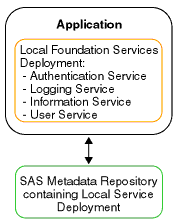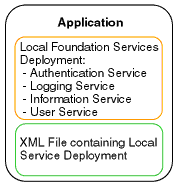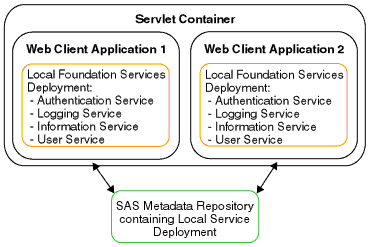Understanding How Applications Locate Foundation Services
Overview of How Applications Locate Foundation Services
Note: Your application can be
either a standard client application or a Web client application that
runs in a servlet container.
-
The application initializes and registers the local Discovery Service with a remote Discovery Service. The application locates the remote Discovery Service by obtaining the Remote Method Invocation (RMI) registry location from a SAS Metadata Repository (or XML file that contains exported metadata) and performing an RMI name lookup on the remote Discovery Service. The remote Discovery Service enables the client to locate remotely deployed SAS Foundation Services.
For example, in A Remote Service Configuration, if an application requests the Logging Service, the application
binds to the local Logging Service. If an application requests the
Session Service, the application uses the remote Discovery Service
to locate and bind to the remote Session Service.
Scenario: Stand-alone Application
A stand-alone application deploys
services locally, uses the services, and terminates the services when
they are no longer needed. If an application does not need to interact
with any other applications, then it can be a stand-alone application
with its own exclusive local service deployment. Services locally
deployed by this application are not available to any other application.
In addition, no remote services are available.
Note: An application can be either
a standard client application or a Web client application that runs
in a servlet container.
When the application
no longer needs the services or is ready to exit, it terminates the
local Discovery Service. The local Discovery Service then destroys
all locally instantiated services.
The following figure
shows a stand-alone application that accesses a service deployment
from a local SAS Metadata Repository:
The following figure
shows a stand-alone application that accesses a service deployment
from an XML file:
Scenario: Services That Can Be Accessed Remotely
To enable applications to access remote services, one application
must deploy the remote services. (The application that deploys the
remote services can then access the services as local services). Instead
of deploying their own set of local services, other applications can
access the remote services. To access the remote service deployment,
applications locate the deploying application's remote Discovery Service
in order to locate and access the deployed remote services. This scenario
is useful if one or more client applications need to use the same
set of services.
In this scenario, Application
1 deploys the remote services and accesses them as local services.
Applications 2, 3, and 4 locate Application 1's remote Discovery Service
in order to access the remote services. Note that Applications 2 and
3 are Web client applications that run in the same servlet container
and each deploy their own local services for their own exclusive use.
To locate the remote-accessible
services (that were deployed by Application 1), Applications 2, 3,
and 4 do the following:
Scenario: Local and Remote-accessible Services
To enable other
applications to access remote services, one application must deploy
the remote services. (The application that deploys the remote services
can then access the services as local services). Instead of deploying
their own set of local services, other applications can access the
remote service deployment. To access the remote service deployment,
applications locate the deploying application's remote Discovery Service
in order to locate and access the deployed remote services. In addition,
these applications can each have their own set of locally deployed
services to which each application has its own exclusive access. This
example is useful when client applications need to have both of the
following:
Note: A foundation service-enabled
application can be either a standard client application or a Web client
application that runs in a servlet container.
In this scenario, Application
1 deploys the remote services and accesses them as local services.
Application 2 locates Application 1's remote Discovery Service in
order to access the remote services. Application 2 also deploys local
services for its own exclusive use.




